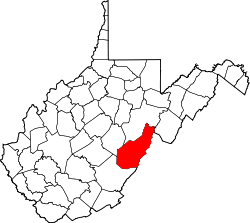Green Bank | |
|---|---|
 Green Bank in 2023 | |
| Coordinates: 38°25′12″N79°49′53″W / 38.42000°N 79.83139°W | |
| Country | United States |
| State | West Virginia |
| County | Pocahontas |
| Area | |
• Total | 3.276 sq mi (8.48 km2) |
| • Land | 3.276 sq mi (8.48 km2) |
| • Water | 0 sq mi (0 km2) |
| Population | |
• Total | 141 |
| • Density | 43.0/sq mi (16.6/km2) |
| Time zone | UTC-5 (Eastern (EST)) |
| • Summer (DST) | UTC-4 (EDT) |
| ZIP codes | 24944 |
Green Bank is a census-designated place in Pocahontas County in West Virginia's Potomac Highlands inside the Allegheny Mountain Range. Green Bank is located along WV 28. Green Bank is home to the Green Bank Observatory and is also close to the Snowshoe Mountain ski resort. As of the 2020 census, its population was 141. [3]
Contents
The community was named for a green riverbank near the original town site. [4]

